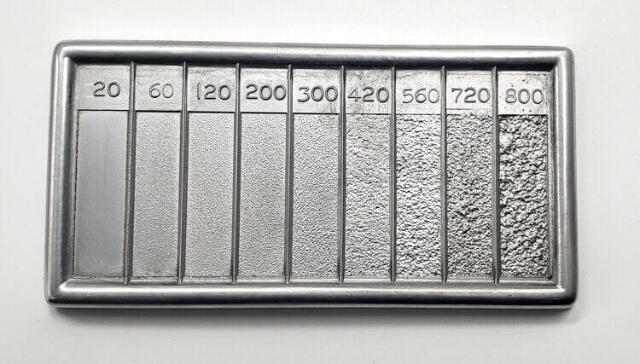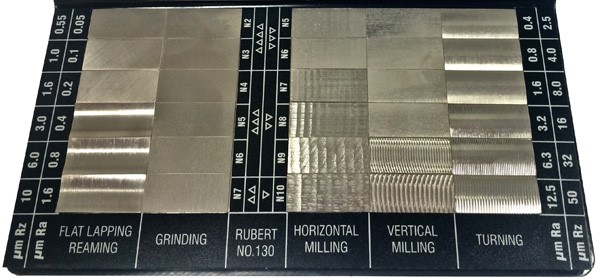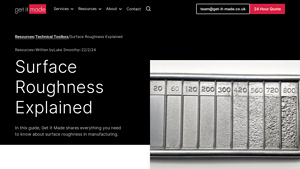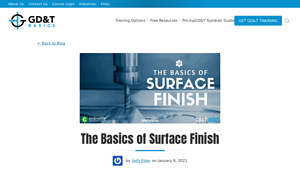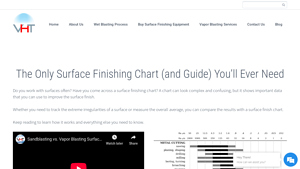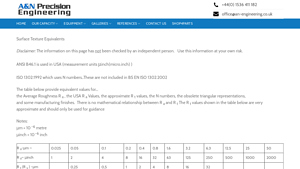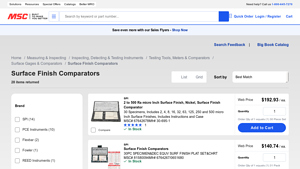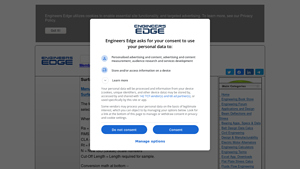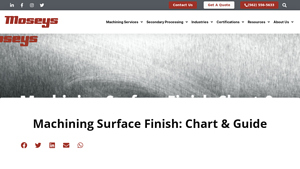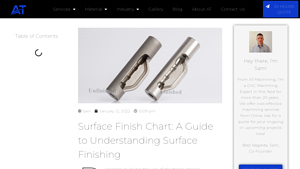Surface Finish Scale Guide: Type, Cost, Top List…
Introduction: Navigating the Global Market for surface finish scale
In today’s competitive landscape, sourcing the right surface finish scale can be a daunting challenge for B2B buyers, especially when considering its critical impact on product performance and market acceptance. Surface finish not only influences the aesthetic appeal of products but also plays a vital role in functionality across various applications, from aerospace components to medical devices. This comprehensive guide delves into the intricacies of surface finish scale, exploring different types, industry-specific applications, and essential supplier vetting processes to ensure optimal quality and compliance.
Understanding the nuances of surface finish is paramount for international buyers, particularly those in emerging markets like Nigeria and Brazil, where manufacturing standards are rapidly evolving. This guide equips procurement professionals with actionable insights into measurement standards, cost considerations, and best practices for selecting suppliers that align with their specific needs. By addressing the complexities of surface roughness, waviness, and lay, we empower buyers to make informed decisions that not only meet technical requirements but also enhance product durability and performance.
With a focus on practical applications and strategic sourcing, this resource aims to streamline the procurement process, ensuring that buyers can confidently navigate the global market for surface finish solutions. Whether you are looking to optimize production efficiency or enhance product quality, this guide serves as your roadmap to successful sourcing in the realm of surface finish scale.
Understanding surface finish scale Types and Variations
| Type Name | Key Distinguishing Features | Primary B2B Applications | Brief Pros & Cons for Buyers |
|---|---|---|---|
| Ra (Average Roughness) | Measures average height of peaks and valleys; widely used. | Aerospace, Automotive, Electronics | Pros: Standardized measurement; easy to communicate. Cons: May not capture surface irregularities effectively. |
| Rz (Average Maximum Height) | Measures the average distance between the highest peaks and lowest valleys; provides a broader view of surface texture. | Medical Devices, Precision Engineering | Pros: Offers a more detailed surface profile. Cons: More complex to calculate and interpret. |
| N4 (Polished Finish) | Extremely smooth surface; often achieved through polishing processes. | High-End Consumer Products, Medical Devices | Pros: Superior aesthetic appeal; reduces friction. Cons: Higher manufacturing costs; may require longer lead times. |
| Bead Blasted Finish | Textured finish created through bead blasting; provides a rougher surface. | Automotive, Aerospace, Consumer Products | Pros: Increases surface adhesion; enhances grip. Cons: May retain dirt and require more maintenance. |
| Anodized Finish | Electrochemical process that enhances corrosion resistance and surface hardness; available in various colors. | Electronics, Automotive, Architectural | Pros: Durable and aesthetically versatile; improves wear resistance. Cons: Limited color options for certain materials; can be more expensive. |
What are the Characteristics of Ra (Average Roughness) and Its Suitability for B2B Buyers?
Ra, or Average Roughness, is a critical metric in surface finish measurement, representing the average height of surface irregularities. This standard is prevalent in various industries, including aerospace and automotive, where precision is paramount. B2B buyers must consider that while Ra is a straightforward measurement, it may overlook specific surface features that could impact product performance. Therefore, it’s essential to align Ra specifications with the intended application to ensure optimal functionality.
How Does Rz (Average Maximum Height) Differ and When Should It Be Used?
Rz measures the average distance between the highest peaks and lowest valleys, providing a more comprehensive understanding of surface texture than Ra. This metric is particularly advantageous in sectors like medical devices and precision engineering, where surface integrity is crucial for performance and safety. Buyers should evaluate Rz when detailed surface profiles are necessary, but they must also be prepared for the complexity of its calculation and interpretation.
What Benefits Does a Polished Finish (N4) Offer for High-End Products?
The N4 polished finish is characterized by an exceptionally smooth surface, often achieved through meticulous polishing techniques. This finish is favored in high-end consumer products and medical devices, where aesthetics and reduced friction are critical. While the polished finish enhances the visual appeal and functionality, B2B buyers should account for the higher production costs and potential lead times associated with this meticulous finishing process.
Why Choose a Bead Blasted Finish for Enhanced Grip?
A bead blasted finish creates a textured surface that enhances grip and adhesion, making it popular in automotive and aerospace applications. This finish is particularly beneficial for components requiring friction, such as handles or grips. However, B2B buyers should consider that while bead blasting improves surface performance, it may also lead to increased dirt retention, necessitating more frequent maintenance.
What Are the Advantages of an Anodized Finish for Durability?
An anodized finish involves an electrochemical process that enhances the corrosion resistance and hardness of metal surfaces, often available in various colors. This finish is widely used in electronics and automotive sectors, where durability and aesthetics are paramount. Buyers should weigh the advantages of increased wear resistance and visual appeal against the limited color options for specific materials and the potential for higher costs associated with anodizing processes.
Key Industrial Applications of surface finish scale
| Industry/Sector | Specific Application of Surface Finish Scale | Value/Benefit for the Business | Key Sourcing Considerations for this Application |
|---|---|---|---|
| Aerospace | Component Manufacturing | Enhanced performance and safety through precise surface finishes | Compliance with stringent industry standards and regulations |
| Automotive | Engine and Transmission Parts | Improved durability and reduced friction for better fuel efficiency | Material compatibility and surface roughness specifications |
| Medical Devices | Surgical Instruments | Ensured biocompatibility and reduced infection risk | Certification of materials and adherence to hygiene standards |
| Electronics | Circuit Board Fabrication | Enhanced conductivity and reliability of electronic components | Precision in surface texture to ensure proper electrical connections |
| Energy Sector | Turbine and Pump Components | Increased efficiency and lifespan of critical machinery | Resistance to corrosion and wear under high-stress conditions |
How is Surface Finish Scale Used in the Aerospace Sector?
In the aerospace industry, the surface finish scale is crucial for manufacturing components that require high precision and reliability. Components such as turbine blades and fuselage parts must meet strict surface roughness standards to ensure performance and safety. Buyers must consider compliance with industry standards like AS9100, which governs quality management systems in aerospace manufacturing. The right surface finish can prevent fatigue failures and enhance aerodynamic efficiency, ultimately leading to safer and more efficient aircraft.
What Role Does Surface Finish Scale Play in Automotive Manufacturing?
The automotive sector utilizes surface finish scales primarily in the production of engine and transmission parts. A smooth surface finish can significantly reduce friction between moving parts, thereby improving fuel efficiency and extending the life of components. Buyers should seek suppliers who can provide detailed specifications on surface roughness (Ra values) and ensure that materials used are compatible with the required finishes. Additionally, understanding the trade-offs between surface finish and manufacturing costs is crucial for maintaining competitive pricing.
Why is Surface Finish Scale Essential for Medical Devices?
In the medical devices industry, surface finish is vital for ensuring the safety and efficacy of surgical instruments. A specific surface finish can enhance biocompatibility, reduce the risk of infection, and improve the overall performance of medical devices. Buyers must prioritize sourcing from manufacturers who comply with ISO 13485 standards and can demonstrate rigorous testing of surface finishes. The surface finish must also be easy to clean and sterilize, making it essential to communicate these requirements clearly in procurement processes.
How Does Surface Finish Scale Affect Electronics Manufacturing?
The electronics industry relies on surface finish scales to ensure the reliability and performance of circuit boards and components. A precise surface finish can enhance conductivity and ensure proper electrical connections, which are critical for device functionality. Buyers should focus on sourcing components that adhere to IPC standards, which outline the requirements for electronic interconnections. Additionally, understanding the implications of surface roughness on solderability and component placement is vital for optimizing manufacturing processes.
What is the Importance of Surface Finish Scale in the Energy Sector?
In the energy sector, particularly in the manufacturing of turbines and pumps, surface finish scales are essential for maximizing efficiency and longevity. A well-defined surface finish can improve the performance of components under high-stress conditions, reducing wear and corrosion. Buyers in this sector should prioritize sourcing materials that meet specific surface roughness requirements to ensure operational reliability. Furthermore, adherence to industry-specific standards for corrosion resistance and mechanical integrity is critical for maintaining safety and efficiency in energy production.
3 Common User Pain Points for ‘surface finish scale’ & Their Solutions
Scenario 1: Inconsistent Surface Finish Leading to Product Failures
The Problem: A manufacturing company specializing in automotive components faces a significant challenge with inconsistent surface finishes on machined parts. These inconsistencies lead to product failures during performance testing, resulting in costly recalls and damage to the company’s reputation. The engineering team struggles to pinpoint the exact cause, as variations in surface roughness are affecting the fit and function of critical components. This problem is exacerbated when the suppliers do not provide clear specifications on the surface finish requirements, leaving the manufacturer uncertain about the necessary tolerances.
The Solution: To overcome this issue, it is crucial to establish clear communication regarding surface finish specifications from the outset. B2B buyers should ensure that they provide precise requirements using standardized metrics such as Ra (average roughness). Engaging in collaborative discussions with suppliers about surface finish expectations, and utilizing surface roughness charts to convey these specifications can eliminate ambiguity. Moreover, implementing a quality assurance protocol that includes surface roughness testing during different stages of production will help monitor consistency. Regular audits and feedback loops with suppliers can also ensure that the surface finish remains within acceptable limits, thus mitigating the risk of product failures.
Scenario 2: High Costs Due to Overly Smooth Surface Finishes
The Problem: A company that manufactures precision medical devices has been facing escalating production costs. The design team insists on exceptionally smooth surface finishes for their products to enhance performance and compliance with strict regulatory standards. However, achieving these finishes through additional machining processes is leading to significantly higher manufacturing costs, which threatens the company’s competitiveness in the market. The procurement team feels pressured to find cost-effective solutions without compromising quality.
The Solution: Buyers should consider a balanced approach to surface finish requirements by evaluating the actual performance needs of the product. Conducting a thorough cost-benefit analysis can help determine the minimum acceptable surface finish that meets regulatory standards without incurring unnecessary expenses. Collaborating closely with suppliers to explore alternative finishing techniques—such as using coatings or different machining methods—can achieve the desired performance at a lower cost. Additionally, investing in advanced surface measurement tools can help optimize the finishing process, ensuring that only the necessary treatments are applied, thus reducing waste and overall costs.
Scenario 3: Challenges in Adapting to Different Surface Finish Standards
The Problem: A global supplier of electronic components is expanding into international markets, including regions in Africa and South America. However, they encounter difficulties in adhering to varying surface finish standards required by different countries. This inconsistency not only complicates the manufacturing process but also results in delays and increased costs due to rework and compliance issues. The procurement team is unsure how to navigate these differences while maintaining product quality and meeting customer expectations.
The Solution: To address this challenge, B2B buyers should invest time in understanding the surface finish standards specific to each target market. This can be achieved by engaging with local experts and industry associations to gain insights into regional requirements. Creating a comprehensive database that includes the surface finish specifications for different markets will serve as a valuable reference. Furthermore, establishing partnerships with local suppliers who are familiar with these standards can streamline the manufacturing process. Proactively communicating with customers about their surface finish needs and being adaptable in production methods will enhance customer satisfaction and build a competitive edge in diverse markets.
Strategic Material Selection Guide for surface finish scale
What Are the Key Properties of Common Materials Used in Surface Finish Scale?
When selecting materials for surface finish applications, understanding their properties is crucial for ensuring optimal product performance. Below, we analyze four common materials used in surface finish scale, focusing on their key properties, pros and cons, and implications for international B2B buyers.
1. Stainless Steel
Key Properties:
Stainless steel is renowned for its excellent corrosion resistance, high-temperature tolerance, and mechanical strength. It typically withstands temperatures up to 870°C (1600°F) and exhibits good pressure ratings, making it suitable for various industrial applications.
Pros & Cons:
The durability of stainless steel is a significant advantage, as it resists wear and tear over time. However, the manufacturing complexity can be high due to its hardness, which may lead to increased machining costs. Additionally, while stainless steel is relatively expensive, its long lifespan often justifies the investment.
Impact on Application:
Stainless steel is compatible with a wide range of media, including corrosive substances, making it ideal for the food, pharmaceutical, and chemical industries. Its surface finish can significantly affect adhesion properties, which is critical for coatings and paints.
Considerations for International Buyers:
Buyers from regions like Africa and South America should ensure compliance with international standards such as ASTM A240 for stainless steel. Understanding local regulations regarding corrosion resistance and hygiene standards is also essential.
2. Aluminum
Key Properties:
Aluminum is lightweight, has good thermal conductivity, and offers moderate corrosion resistance. It typically operates effectively at temperatures up to 600°C (1112°F) and is often used in applications where weight savings are critical.
Pros & Cons:
The primary advantage of aluminum is its low weight, making it ideal for aerospace and automotive applications. However, it is less durable than stainless steel and may require additional surface treatments to enhance its corrosion resistance. The cost of aluminum can vary, but it is generally more affordable than high-grade stainless steel.
Impact on Application:
Aluminum’s surface finish can affect its electrical conductivity, making it suitable for electronic components. However, its lower strength compared to steel may limit its use in high-stress applications.
Considerations for International Buyers:
B2B buyers should be aware of standards like ASTM B221 for aluminum extrusions. Additionally, regional preferences for aluminum alloys may influence selection, particularly in the Middle East and Europe, where specific grades are favored for construction and automotive applications.
3. Carbon Steel
Key Properties:
Carbon steel is known for its high strength and toughness. It can withstand high temperatures (up to 400°C or 752°F) and is often used in structural applications.
Pros & Cons:
The key advantage of carbon steel is its cost-effectiveness, making it a popular choice for various applications. However, it is susceptible to corrosion without proper surface treatment, which can limit its use in harsh environments. The manufacturing process can also be complex due to the need for precise machining.
Impact on Application:
Carbon steel’s surface finish is critical for applications requiring high wear resistance, such as in machinery and tooling. Its rougher finishes can enhance adhesion for coatings, but buyers must consider the potential for rust in humid climates.
Considerations for International Buyers:
Compliance with standards like ASTM A36 is essential for carbon steel applications. Buyers in humid regions, such as parts of Africa, should prioritize surface treatments to prevent corrosion.
4. Plastics (e.g., ABS, PVC)
Key Properties:
Plastics like ABS and PVC are lightweight, resistant to chemicals, and have good electrical insulation properties. They typically operate effectively at lower temperatures, around 80-100°C (176-212°F).
Pros & Cons:
The main advantage of plastics is their versatility and lower cost compared to metals. However, they may not withstand high temperatures or mechanical stress as well as metals, which can limit their use in certain applications.
Impact on Application:
The surface finish of plastics can significantly affect their aesthetic appeal and functionality, especially in consumer products. They can be easily textured or polished to achieve desired finishes, enhancing visual appeal.
Considerations for International Buyers:
B2B buyers should consider compliance with standards such as ASTM D638 for plastics. Regional preferences for specific plastic types may also influence material selection, particularly in consumer markets in Europe and South America.
Summary Table
| Material | Typical Use Case for surface finish scale | Key Advantage | Key Disadvantage/Limitation | Relative Cost (Low/Med/High) |
|---|---|---|---|---|
| Stainless Steel | Food processing, pharmaceutical equipment | Excellent corrosion resistance | High manufacturing complexity | High |
| Aluminum | Aerospace, automotive components | Lightweight and good thermal conductivity | Lower durability compared to steel | Medium |
| Carbon Steel | Machinery, structural applications | Cost-effective and high strength | Susceptible to corrosion | Low |
| Plastics | Consumer products, electrical housings | Versatile and low cost | Limited temperature and stress resistance | Low |
In-depth Look: Manufacturing Processes and Quality Assurance for surface finish scale
What Are the Key Stages in the Manufacturing Process for Surface Finish Scale?
The manufacturing process for achieving the desired surface finish scale is a multi-stage operation that requires precision and attention to detail. The main stages include material preparation, forming, assembly, and finishing. Each stage is crucial for ensuring that the final product meets the specified surface finish requirements.
Material Preparation
This initial stage involves selecting the appropriate materials based on the intended application and required surface characteristics. Common materials include metals, plastics, and composites. The preparation phase may involve cutting, grinding, or machining the material to achieve the desired dimensions and surface roughness. This step is critical as the quality of the raw material directly influences the surface finish of the final product.
Forming
During the forming stage, various techniques are employed to shape the material. This can include processes such as CNC machining, injection molding, or extrusion. The choice of technique will depend on the product design and material type. For instance, CNC machining allows for precise control over surface roughness, while injection molding can provide a smoother finish straight out of the mold. It’s essential to select the right forming process to minimize the need for extensive finishing work later.
Assembly
In applications where multiple components are involved, the assembly stage becomes vital. Proper assembly techniques ensure that parts fit together seamlessly without compromising the surface finish. Techniques such as laser welding or adhesive bonding may be used, depending on the materials involved. Special care must be taken to avoid scratching or damaging the surface finish during this stage.
Finishing
The finishing stage is where the surface finish scale is perfected. Techniques such as polishing, bead blasting, or anodizing may be employed to achieve the desired level of roughness or smoothness. Each method serves a specific purpose; for example, polishing is used for a high-gloss finish, while bead blasting can create a textured surface. This stage is crucial for enhancing the aesthetic appeal and functionality of the product, such as improving corrosion resistance or facilitating better adhesion of coatings.
How Do Quality Assurance Practices Ensure Surface Finish Compliance?
Quality assurance (QA) is a critical component in the manufacturing process, especially when it comes to maintaining consistent surface finishes. Implementing robust QA practices helps to ensure that products meet international standards and customer expectations.
International Standards and Industry-Specific Certifications
Many industries adhere to established quality standards such as ISO 9001, which sets requirements for a quality management system. Additionally, industry-specific certifications, such as CE marking for European markets or API standards in the oil and gas sector, ensure that products meet specific safety and performance criteria. B2B buyers should verify that their suppliers are compliant with these standards to ensure product reliability.
Quality Control Checkpoints
Effective quality control involves several checkpoints throughout the manufacturing process, including Incoming Quality Control (IQC), In-Process Quality Control (IPQC), and Final Quality Control (FQC).
– IQC: This initial inspection verifies that incoming materials meet specified requirements before they enter the production line.
– IPQC: Conducted during the manufacturing process, this stage ensures that the production methods are yielding parts within the desired surface finish specifications.
– FQC: Final inspections are performed before shipping, focusing on the overall product quality, including surface finish.
Common Testing Methods for Surface Finish
Various methods are employed to measure surface roughness, including contact profilometry, optical methods, and laser scanning. These tests provide quantitative data on surface characteristics, allowing manufacturers to ensure compliance with specified Ra values and other metrics.
How Can B2B Buyers Verify Supplier Quality Control?
B2B buyers must take proactive steps to ensure that their suppliers maintain high-quality standards. Several strategies can be employed to verify supplier quality control.
Audits and Site Visits
Conducting audits or on-site visits can provide invaluable insights into a supplier’s manufacturing processes and quality assurance practices. During these audits, buyers should assess the supplier’s adherence to international standards, evaluate their quality control protocols, and observe the handling of materials to ensure proper care is taken to maintain surface finishes.
Requesting Quality Reports
Buyers should request detailed quality reports that outline the results of inspections and tests performed on products. These reports should include data on surface roughness measurements, compliance with specifications, and any corrective actions taken in case of discrepancies. Such documentation serves as proof of the supplier’s commitment to quality.
Utilizing Third-Party Inspection Services
Engaging third-party inspection services can add an additional layer of assurance. Independent inspectors can provide unbiased evaluations of the supplier’s quality control processes and product quality. This is particularly important for international buyers who may face challenges in assessing suppliers remotely.
What Are the Specific Quality Control Nuances for International B2B Buyers?
For international B2B buyers, particularly those from regions such as Africa, South America, the Middle East, and Europe, several nuances in quality control must be considered.
Cultural and Regulatory Differences
Understanding the cultural and regulatory landscape in different regions is crucial. Buyers should be aware that quality standards may vary significantly across countries, and what is acceptable in one market may not be in another. Familiarizing oneself with local regulations and quality expectations can help mitigate risks.
Logistics and Supply Chain Considerations
International logistics can complicate quality control. Delays in shipping, customs issues, or changes in handling can affect the final product’s surface finish. Buyers should work closely with suppliers to ensure that quality control measures extend throughout the entire supply chain, from production to delivery.
Communication and Language Barriers
Effective communication is vital in maintaining quality standards. Language barriers can lead to misunderstandings regarding specifications and requirements. B2B buyers should ensure that all technical documents are clear and that there is a shared understanding of quality expectations between themselves and their suppliers.
By understanding the intricacies of manufacturing processes and quality assurance, B2B buyers can make informed decisions that enhance their procurement strategies and ensure the delivery of high-quality products with the desired surface finish.
Practical Sourcing Guide: A Step-by-Step Checklist for ‘surface finish scale’
Introduction
This guide serves as a comprehensive checklist for B2B buyers focused on procuring surface finish scales. Understanding and specifying surface finishes is critical in ensuring the performance, durability, and aesthetic appeal of manufactured products. The following steps will help you navigate the sourcing process efficiently and effectively.
Step 1: Define Your Technical Specifications
Begin by clearly outlining the surface finish requirements for your project. This includes specifying the desired surface roughness (Ra), waviness, and lay, which can significantly impact product performance. Consider the application of your product; for instance, a smoother finish may be required for parts interacting closely, while a rougher texture might be necessary for better adhesion.
Step 2: Research Industry Standards
Familiarize yourself with relevant industry standards and specifications that govern surface finishes. Standards such as ISO 1302 and ASME B46.1 provide guidelines on how to measure and communicate surface roughness. Understanding these standards ensures that your specifications align with industry expectations, facilitating clearer communication with suppliers.
Step 3: Evaluate Potential Suppliers
Before committing to any supplier, conduct thorough evaluations. Request company profiles, certifications, and case studies demonstrating their capability in delivering the required surface finishes. Consider their experience with similar projects or industries, and seek references from previous clients to gauge reliability and quality.
Step 4: Assess Manufacturing Capabilities
Evaluate the manufacturing capabilities of potential suppliers to ensure they can meet your surface finish requirements. Inquire about the technologies they use, such as CNC machining, polishing, or secondary finishing processes. Understanding their capabilities will help you ascertain whether they can achieve the desired surface roughness consistently.
Step 5: Verify Quality Control Processes
Quality assurance is paramount in surface finishing. Investigate the supplier’s quality control processes, including the equipment and techniques used to measure surface roughness. A supplier should have established protocols for testing and verifying surface finishes to ensure compliance with your specifications.
Step 6: Request Samples for Evaluation
Always request samples of finished products to assess the surface finish quality firsthand. This step allows you to evaluate the texture, appearance, and overall quality of the supplier’s work. Comparing samples against your specifications will enable you to make informed decisions before placing large orders.
Step 7: Negotiate Terms and Conditions
Once you’ve identified a suitable supplier, negotiate terms that protect your interests. This includes discussing pricing, lead times, and payment terms. Ensure that both parties clearly understand the surface finish requirements and any penalties for non-compliance to avoid misunderstandings in the future.
By following this checklist, B2B buyers can streamline their sourcing process for surface finish scales, ensuring they select the right suppliers who can meet their technical and quality demands.
Comprehensive Cost and Pricing Analysis for surface finish scale Sourcing
What Are the Key Cost Components in Surface Finish Scale Sourcing?
When sourcing surface finish scales, understanding the cost structure is vital for international B2B buyers. The primary components influencing costs include materials, labor, manufacturing overhead, tooling, quality control (QC), logistics, and profit margins.
-
Materials: The choice of materials directly impacts the cost. For instance, high-grade metals or specialized plastics may increase the price due to their inherent properties and sourcing challenges.
-
Labor: Skilled labor is essential for precision machining and finishing processes. The labor cost can vary significantly based on the region and the complexity of the surface finish required.
-
Manufacturing Overhead: This includes costs associated with facility operations, utilities, and equipment maintenance. Overhead can differ across suppliers, especially between regions like Africa and Europe.
-
Tooling: The need for specialized tools or molds can add to initial costs. Custom tooling is often necessary for unique designs or high-volume production runs.
-
Quality Control: Rigorous QC processes ensure that products meet specified standards, which can incur additional costs. Certifications for quality standards like ISO can also influence pricing.
-
Logistics: Shipping costs, particularly for international transactions, can be substantial. Factors such as distance, freight methods, and customs duties must be considered.
-
Margin: Suppliers will include their profit margin in the pricing. This margin can be influenced by market competition and perceived value.
How Do Price Influencers Affect Surface Finish Scale Costs?
Several factors can affect pricing in surface finish scale sourcing, particularly for B2B buyers from diverse regions.
-
Volume/MOQ: Minimum order quantities (MOQ) often dictate pricing. Higher volumes typically lead to lower per-unit costs due to economies of scale.
-
Specifications and Customization: Customized surface finishes or specific tolerances can increase costs. Clearly defining specifications upfront can help mitigate unexpected expenses.
-
Materials: The choice of materials not only affects the initial cost but also the long-term durability and performance of the finished product.
-
Quality and Certifications: Products that come with certifications or meet stringent quality standards may carry a premium price. Buyers should weigh the benefits of these certifications against their needs.
-
Supplier Factors: Supplier reputation, reliability, and location can influence pricing. Established suppliers may charge more for their proven track record, while emerging suppliers might offer competitive pricing to gain market share.
-
Incoterms: Understanding Incoterms is crucial for international buyers as they dictate the responsibilities of buyers and sellers in terms of shipping, insurance, and tariffs, impacting the total cost.
What Negotiation Strategies Can Optimize Cost-Efficiency?
For international B2B buyers, particularly from regions like Africa and South America, employing effective negotiation strategies can lead to cost savings.
-
Seek Multiple Quotes: Obtaining quotes from several suppliers can provide leverage in negotiations. It allows buyers to compare pricing and services, ensuring they receive the best deal.
-
Clarify Specifications: Ensure that all specifications are clearly communicated to avoid misunderstandings that could lead to increased costs later in the process.
-
Discuss Long-Term Partnerships: Establishing a long-term relationship with a supplier can often lead to better pricing and terms, as suppliers value consistency in business.
-
Evaluate Total Cost of Ownership (TCO): Consider not just the purchase price but also the TCO, which includes maintenance, durability, and potential downtime costs. A higher initial investment may yield lower long-term costs.
What Are the Pricing Nuances for International B2B Buyers?
International buyers must navigate unique pricing nuances when sourcing surface finishes. Fluctuations in currency exchange rates can affect pricing stability. Additionally, varying tariffs and import duties must be factored into the final cost.
Buyers should also be aware of regional market conditions; for example, suppliers in Europe may have different pricing structures compared to those in Africa or South America due to local economic factors. Understanding these nuances can empower buyers to make informed purchasing decisions.
Disclaimer on Indicative Prices
Pricing for surface finish scales can vary widely based on numerous factors. The insights provided are indicative and should be considered as a starting point for discussions with potential suppliers. Always conduct thorough due diligence to obtain accurate pricing tailored to your specific needs and circumstances.
Alternatives Analysis: Comparing surface finish scale With Other Solutions
Introduction to Alternatives in Surface Finish Solutions
When it comes to achieving the desired surface finish for manufactured components, businesses have several approaches at their disposal. The surface finish scale is a widely recognized method for quantifying and specifying surface roughness, but alternative solutions exist that can cater to various manufacturing needs and operational constraints. Understanding these alternatives can help B2B buyers make informed decisions about which method best aligns with their production requirements.
Comparison Table of Surface Finish Solutions
| Comparison Aspect | Surface Finish Scale | Alternative 1: Polishing | Alternative 2: Bead Blasting |
|---|---|---|---|
| Performance | Provides a standardized measure of roughness, ensuring consistent quality. | Achieves a smooth, reflective surface ideal for aesthetic applications. | Creates a uniform texture that enhances adhesion for coatings. |
| Cost | Moderate; costs can vary based on required precision and scale. | Higher initial costs due to labor-intensive processes. | Generally lower cost; effective for bulk applications. |
| Ease of Implementation | Requires specific tools and knowledge of surface roughness metrics. | May require specialized equipment and skilled labor. | Easier to implement; commonly available equipment. |
| Maintenance | Low; once established, requires minimal upkeep. | Moderate; polishing tools require regular maintenance. | Low; equipment generally has minimal maintenance needs. |
| Best Use Case | Precision engineering and applications where surface roughness is critical. | High-end consumer products, medical devices, and applications requiring aesthetics. | Automotive and aerospace components where surface texture is essential for coatings. |
Detailed Breakdown of Alternatives
Polishing
Polishing is a surface finishing technique that enhances the smoothness and aesthetic appeal of a component. It is particularly effective for applications where appearance is critical, such as in consumer electronics or luxury products. However, the process can be labor-intensive and may involve higher costs due to the need for skilled labor and specialized equipment. While polishing yields excellent results in terms of gloss and smoothness, it may not be suitable for all manufacturing contexts, particularly where high volumes are required.
Bead Blasting
Bead blasting involves propelling small beads against a surface to create a uniform texture. This method is advantageous for applications that require enhanced adhesion for coatings, such as in automotive and aerospace industries. The cost-effectiveness of bead blasting makes it appealing for large-scale manufacturing, as it can be performed quickly and with minimal equipment. However, it may not achieve the fine level of smoothness that polishing or surface finish scales can provide, which could be a drawback for precision applications.
Conclusion: Choosing the Right Surface Finish Solution
For B2B buyers considering the optimal surface finish solution, the choice between the surface finish scale, polishing, and bead blasting should be based on specific application requirements, budget constraints, and production volume. The surface finish scale is ideal for precision engineering projects where detailed specifications are critical. In contrast, polishing is suited for high-end applications that prioritize appearance, while bead blasting offers a cost-effective solution for achieving functional surface textures. By carefully evaluating these factors, businesses can select the method that best meets their operational needs and enhances their product quality.
Essential Technical Properties and Trade Terminology for surface finish scale
What Are the Key Technical Properties of Surface Finish Scale?
Understanding the essential technical properties related to surface finish is critical for B2B buyers who want to ensure that their products meet specific functional and aesthetic requirements. Here are several key specifications that are vital in the context of surface finish:
1. Surface Roughness (Ra)
Surface roughness is a quantitative measure of the texture of a surface, typically expressed as the arithmetic average of the absolute deviations of the surface profile from a mean line. In B2B contexts, the Ra value is crucial as it affects how a product interacts with its environment. A lower Ra value generally indicates a smoother surface, which can enhance performance in applications like sliding mechanisms, while higher Ra values may be required for better grip or adhesion.
2. Waviness (W)
Waviness refers to the more significant, longer wavelength deviations from the nominal surface. It is essential in determining how surfaces will fit together and function, especially in assemblies where alignment is critical. Understanding waviness can help manufacturers avoid issues related to misalignment and ensure better performance of components.
3. Material Grade
Material grade specifies the quality and composition of the material used in manufacturing. Different grades can affect the surface finish due to variations in hardness, ductility, and corrosion resistance. Buyers must consider material grades to ensure compatibility with their intended applications, especially in industries like aerospace and automotive, where performance is paramount.
4. Tolerance
Tolerance defines the permissible limit of variation in a physical dimension or measured value. In surface finishing, this includes the acceptable roughness levels and overall dimensional accuracy. Tolerances are critical for ensuring that parts fit together correctly and function as intended, making it essential for procurement teams to specify tolerances clearly in their RFQs.
5. Coating and Treatment Options
Surface treatments and coatings can significantly influence the surface finish of a product. Processes like anodizing, plating, or painting can improve corrosion resistance, aesthetic appeal, and wear resistance. Buyers should consider these options based on the environmental conditions their products will face and the desired performance characteristics.
What Are Common Trade Terms Related to Surface Finish Scale?
In the realm of surface finish and manufacturing, specific jargon is commonly used. Familiarity with these terms will help B2B buyers navigate discussions and contracts effectively.
1. OEM (Original Equipment Manufacturer)
OEM refers to a company that produces parts or equipment that may be marketed by another manufacturer. Understanding OEM relationships is crucial for buyers, as they often dictate quality standards and surface finish requirements for components used in final products.
2. MOQ (Minimum Order Quantity)
MOQ indicates the smallest quantity of a product that a supplier is willing to sell. This term is significant for B2B buyers as it impacts inventory management and cost efficiency. Knowing the MOQ helps companies plan their purchasing strategy and budget accordingly.
3. RFQ (Request for Quotation)
An RFQ is a document that a buyer sends to suppliers to solicit price quotes for specific products or services. For surface finishes, including detailed specifications such as Ra, waviness, and tolerances in the RFQ can lead to more accurate and competitive pricing.
4. Incoterms (International Commercial Terms)
Incoterms are internationally recognized rules that define the responsibilities of buyers and sellers in international transactions. They specify who is responsible for shipping, insurance, and tariffs, which can significantly affect the total cost and logistics of acquiring surface-finished products.
5. Lead Time
Lead time is the period between the initiation of an order and its completion. In manufacturing, understanding lead times for surface finishing processes is vital for project planning and delivery schedules, especially in industries with tight timelines.
By grasping these essential properties and terminology, B2B buyers can make informed decisions that align with their operational needs and ensure optimal product performance.
Navigating Market Dynamics and Sourcing Trends in the surface finish scale Sector
What Are the Current Market Dynamics and Key Trends Influencing the Surface Finish Scale Sector?
The global surface finish scale market is witnessing substantial growth, driven by several factors including the increasing demand for precision-engineered components across various industries such as aerospace, automotive, and medical devices. In regions like Africa, South America, the Middle East, and Europe, the surge in manufacturing activities is leading to heightened awareness of surface finish specifications. As international B2B buyers prioritize high-quality standards, they are increasingly adopting advanced manufacturing technologies such as CNC machining, 3D printing, and laser cutting, which allow for precise surface finish control.
Emerging trends include the integration of digital technologies in the sourcing process. For instance, the use of AI-driven platforms is streamlining supplier selection and optimizing inventory management, thereby reducing lead times and costs. Additionally, the rise of on-demand manufacturing is enabling businesses to respond swiftly to market fluctuations, offering a competitive edge. Buyers are also leaning towards suppliers that can provide detailed surface roughness metrics and certifications, enhancing transparency in the supply chain.
How Are Sustainability and Ethical Sourcing Impacting the Surface Finish Scale Market?
Sustainability has become a pivotal concern within the surface finish scale sector. As international regulations tighten around environmental impact, B2B buyers are increasingly scrutinizing their supply chains. This trend is particularly pronounced in regions such as Europe, where sustainability practices are not just encouraged but mandated. Companies are now expected to adopt ethical sourcing strategies that minimize environmental harm and promote social responsibility.
The use of ‘green’ certifications and materials is gaining traction. B2B buyers are gravitating towards suppliers who utilize eco-friendly surface finishing techniques and materials that comply with environmental standards. For instance, processes that reduce waste and energy consumption, such as water-based coatings and biodegradable materials, are highly sought after. By aligning with suppliers that prioritize sustainability, businesses can enhance their brand reputation and appeal to a conscientious consumer base, thereby driving growth in their respective markets.
What Is the Evolution of the Surface Finish Scale Sector and Its Relevance to B2B Buyers?
The evolution of the surface finish scale sector can be traced back to the industrial revolution, where the need for precision in manufacturing began to take shape. Early methods of finishing were rudimentary, primarily focused on aesthetics. However, as technology progressed, so did the understanding of how surface finish directly impacts product performance, durability, and safety.
Today, surface finishing is not merely an aesthetic consideration but a critical component of product functionality. The introduction of advanced measurement techniques and standards, such as Ra and Rz values, has allowed for more precise control over surface characteristics. This evolution is particularly relevant for B2B buyers who must ensure that their products meet specific industry standards and customer expectations. Understanding the historical context and advancements in surface finishing technologies enables buyers to make informed sourcing decisions that align with their operational goals and market demands.
Frequently Asked Questions (FAQs) for B2B Buyers of surface finish scale
-
How do I determine the required surface finish for my product?
To determine the required surface finish, consider the product’s application, environment, and performance requirements. Consult industry standards relevant to your sector, such as ISO or ASME. Collaborate with engineers and manufacturing partners to define specific parameters, including roughness average (Ra) and other characteristics like waviness and lay. Use surface roughness charts to communicate your needs clearly, ensuring all parties understand the specifications to avoid costly errors in production. -
What is the best surface finish for precision machined parts?
The best surface finish for precision machined parts often depends on the intended use. A common requirement is an Ra value between 0.8 to 1.6 micrometers, which balances performance with manufacturability. For components requiring low friction, a smoother finish (Ra < 0.8) is ideal. Conversely, parts needing higher friction, like bicycle seat posts, may benefit from a rougher finish. Always consider the trade-offs between surface finish quality and production costs when selecting the appropriate finish. -
What are the key factors in vetting suppliers for surface finish scale?
When vetting suppliers for surface finish scale, assess their industry experience, certifications (such as ISO 9001), and production capabilities. Request samples of their previous work to evaluate quality and consistency. Investigate their technical expertise, especially in meeting specific surface finish requirements. Additionally, consider their communication, lead times, and flexibility in handling custom orders, which are crucial for establishing a reliable partnership. -
What are typical minimum order quantities (MOQ) for surface finish products?
Minimum order quantities for surface finish products can vary widely based on the supplier and the specific service required. Generally, MOQs can range from a few pieces for specialized services to thousands for standard finishes. Discuss your project needs directly with potential suppliers to negotiate MOQs that align with your production requirements. Some suppliers may offer flexible MOQs for first-time orders or prototypes to foster long-term business relationships. -
What payment terms should I expect when sourcing surface finish services internationally?
Payment terms for international surface finish services typically range from 30% upfront and 70% upon delivery to full payment in advance for smaller orders. It’s essential to clarify these terms before engaging in a contract. Some suppliers might offer payment through letters of credit, which provide additional security for large transactions. Always ensure that the payment terms are documented in the contract to prevent misunderstandings. -
How can I ensure quality assurance in surface finish products?
To ensure quality assurance in surface finish products, establish clear specifications and standards before production begins. Request a detailed quality assurance plan from your supplier, which should include inspection processes and testing methods. Regular communication during the production phase can help address any issues early. Additionally, consider third-party inspections or certifications to validate the surface finish meets your requirements before final acceptance. -
What logistics considerations should I keep in mind when sourcing surface finish services?
When sourcing surface finish services, consider lead times, shipping methods, and potential customs regulations that may affect delivery. Ensure the supplier can provide reliable shipping options that align with your project timeline. Additionally, factor in import duties, taxes, and the availability of local support for handling any logistics-related issues. Clear communication with your supplier about logistics can help prevent delays and ensure a smooth supply chain process. -
How does surface finish impact the performance of my product?
Surface finish significantly impacts product performance by affecting friction, wear, adhesion, and corrosion resistance. A smoother finish can reduce friction, enhancing the durability of moving parts, while a rougher finish may improve grip and adhesion for coatings. Understanding the relationship between surface finish and product functionality is crucial, as improper finishes can lead to premature failure or reduced efficiency. Always align surface finish specifications with the intended application to optimize performance.
Important Disclaimer & Terms of Use
⚠️ Important Disclaimer
The information provided in this guide, including content regarding manufacturers, technical specifications, and market analysis, is for informational and educational purposes only. It does not constitute professional procurement advice, financial advice, or legal advice.
While we have made every effort to ensure the accuracy and timeliness of the information, we are not responsible for any errors, omissions, or outdated information. Market conditions, company details, and technical standards are subject to change.
B2B buyers must conduct their own independent and thorough due diligence before making any purchasing decisions. This includes contacting suppliers directly, verifying certifications, requesting samples, and seeking professional consultation. The risk of relying on any information in this guide is borne solely by the reader.
Top 8 Surface Finish Scale Manufacturers & Suppliers List
1. Get It Made – Manufacturing Services
Domain: get-it-made.co.uk
Registered: 2014 (11 years)
Introduction: Get It Made offers a range of manufacturing services including CNC Machining (5 axis CNC machining, CNC turning, CNC milling), 3D Printing (with diverse materials and color options), Subtractive CNC, Metal Forming, Custom Aluminium Extrusion, Custom Sheet Metal Fabrication, Assembly & Welding, Moulding & Casting (Plastic Injection Moulding, Aluminium Die Casting, Metal Injection Moulding), and Add…
2. GD&T Basics – Surface Finish Standards
Domain: gdandtbasics.com
Registered: 2014 (11 years)
Introduction: Surface finish describes the texture of a surface, often specified in technical drawings for mechanical parts. Key elements include roughness, lay, and waviness. The ASME Y14.36M Surface Texture Symbols standard and B41.6 Surface Texture Standard provide guidelines for specification and measurement. Roughness is the most commonly specified aspect, measured using a profilometer, with parameters Ra …
3. Vapor Honing Technologies – Essential Surface Finishing Guide
Domain: vaporhoningtechnologies.com
Introduction: The Only Surface Finishing Chart (and Guide) You’ll Ever Need provides essential information on surface finishes, including definitions, measurement methods, and key parameters. It explains the importance of surface finishes in equipment performance, how to measure them using contact and non-contact methods, and the various units used in surface finishing charts. Key measurement parameters discuss…
4. An Engineering – Surface Finish Chart
Domain: an-engineering.co.uk
Registered: 2012 (13 years)
Introduction: Surface Finish Chart provides equivalent values for Average Roughness (R a), USA R a Values, approximate R t values, N numbers, and manufacturing finishes. It includes a conversion table for Ra Micron (µm) to Grit, with specific values for different finishes such as Mirror, Ground Finishes, and Rough Machined. The chart also outlines rules of thumb for surface finish equivalents of N grades and Ra…
5. MSC Direct – Surface Finish Comparators
Domain: mscdirect.com
Registered: 1996 (29 years)
Introduction: This company, MSC Direct – Surface Finish Comparators, is a notable entity in the market. For specific product details, it is recommended to visit their website directly.
6. Engineers Edge – Surface Roughness Conversion Chart
Domain: engineersedge.com
Registered: 2000 (25 years)
Introduction: Surface Roughness Conversion Chart provides conversions between industry standard units of surface finish or roughness. Key parameters include: Ra (Roughness average in micro-meters & micro-inches), RMS (Root Mean Square in micro-inches), CLA (Center Line average in micro-inches), Rt (Roughness total in microns), and Cut-Off Length (Length required for sample). Conversion factors are provided for …
7. Moseys – Precision Machining Services
Domain: moseys.com
Registered: 2000 (25 years)
Introduction: Moseys offers precision machining services that focus on achieving high-quality surface finishes. Their capabilities include various machining processes that ensure optimal surface quality for different materials. The company emphasizes the importance of surface finish in enhancing the functionality and aesthetics of machined parts.
8. At Machining – Surface Finish Guide
Domain: at-machining.com
Registered: 2014 (11 years)
Introduction: Surface Finish Chart: A guide to understanding surface finishing processes. Key characteristics of surface finish include surface roughness, waviness, and lay. Surface finish affects durability, performance, lubrication, friction, and corrosion resistance. Measurement methods include contact methods (stylus probe), non-contact methods (optical, laser, X-ray), comparison methods, and in-process mea…
Strategic Sourcing Conclusion and Outlook for surface finish scale
In today’s competitive global market, understanding and implementing the right surface finish specifications is crucial for product performance and reliability. For international B2B buyers, especially in regions like Africa, South America, the Middle East, and Europe, strategic sourcing of surface finish solutions can significantly influence production efficiency and product quality. By prioritizing surface finish requirements, businesses can enhance adhesion, reduce friction, and ensure better wear resistance, ultimately leading to improved product longevity and customer satisfaction.
As you navigate your sourcing strategies, consider leveraging comprehensive resources and expert insights to select the appropriate surface finish processes tailored to your specific applications. Engaging with suppliers who offer a variety of finishing options can provide the flexibility needed to meet diverse market demands.
Looking ahead, the importance of precise surface finishing will only grow as industries evolve and the push for sustainability increases. Now is the time to strengthen your sourcing strategies and collaborate with manufacturers that align with your quality standards. Equip your business for success by investing in surface finish solutions that enhance both performance and aesthetic appeal, setting the stage for future growth and innovation.
